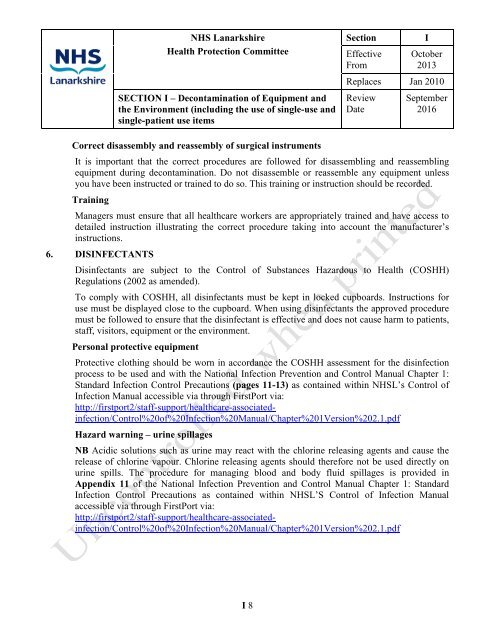Decontamination of Equipment and the ... - NHS Lanarkshire
Decontamination of Equipment and the ... - NHS Lanarkshire
Decontamination of Equipment and the ... - NHS Lanarkshire
You also want an ePaper? Increase the reach of your titles
YUMPU automatically turns print PDFs into web optimized ePapers that Google loves.
<strong>NHS</strong> <strong>Lanarkshire</strong><br />
Health Protection Committee<br />
SECTION I – <strong>Decontamination</strong> <strong>of</strong> <strong>Equipment</strong> <strong>and</strong><br />
<strong>the</strong> Environment (including <strong>the</strong> use <strong>of</strong> single-use <strong>and</strong><br />
single-patient use items<br />
Section<br />
Effective<br />
From<br />
I<br />
October<br />
2013<br />
Replaces Jan 2010<br />
Review<br />
Date<br />
September<br />
2016<br />
Correct disassembly <strong>and</strong> reassembly <strong>of</strong> surgical instruments<br />
It is important that <strong>the</strong> correct procedures are followed for disassembling <strong>and</strong> reassembling<br />
equipment during decontamination. Do not disassemble or reassemble any equipment unless<br />
you have been instructed or trained to do so. This training or instruction should be recorded.<br />
Training<br />
Managers must ensure that all healthcare workers are appropriately trained <strong>and</strong> have access to<br />
detailed instruction illustrating <strong>the</strong> correct procedure taking into account <strong>the</strong> manufacturer’s<br />
instructions.<br />
6. DISINFECTANTS<br />
Disinfectants are subject to <strong>the</strong> Control <strong>of</strong> Substances Hazardous to Health (COSHH)<br />
Regulations (2002 as amended).<br />
To comply with COSHH, all disinfectants must be kept in locked cupboards. Instructions for<br />
use must be displayed close to <strong>the</strong> cupboard. When using disinfectants <strong>the</strong> approved procedure<br />
must be followed to ensure that <strong>the</strong> disinfectant is effective <strong>and</strong> does not cause harm to patients,<br />
staff, visitors, equipment or <strong>the</strong> environment.<br />
Personal protective equipment<br />
Protective clothing should be worn in accordance <strong>the</strong> COSHH assessment for <strong>the</strong> disinfection<br />
process to be used <strong>and</strong> with <strong>the</strong> National Infection Prevention <strong>and</strong> Control Manual Chapter 1:<br />
St<strong>and</strong>ard Infection Control Precautions (pages 11-13) as contained within <strong>NHS</strong>L’s Control <strong>of</strong><br />
Infection Manual accessible via through FirstPort via:<br />
http://firstport2/staff-support/healthcare-associatedinfection/Control%20<strong>of</strong>%20Infection%20Manual/Chapter%201Version%202.1.pdf<br />
Hazard warning – urine spillages<br />
NB Acidic solutions such as urine may react with <strong>the</strong> chlorine releasing agents <strong>and</strong> cause <strong>the</strong><br />
release <strong>of</strong> chlorine vapour. Chlorine releasing agents should <strong>the</strong>refore not be used directly on<br />
urine spills. The procedure for managing blood <strong>and</strong> body fluid spillages is provided in<br />
Appendix 11 <strong>of</strong> <strong>the</strong> National Infection Prevention <strong>and</strong> Control Manual Chapter 1: St<strong>and</strong>ard<br />
Infection Control Precautions as contained within <strong>NHS</strong>L’S Control <strong>of</strong> Infection Manual<br />
accessible via through FirstPort via:<br />
http://firstport2/staff-support/healthcare-associatedinfection/Control%20<strong>of</strong>%20Infection%20Manual/Chapter%201Version%202.1.pdf<br />
I 8

















